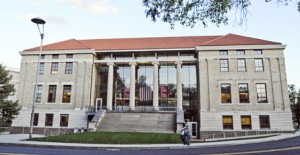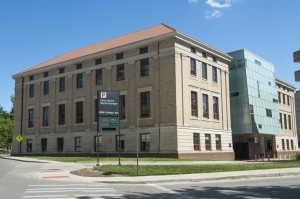By: Sam Richards
The skyline of any city is a major symbol for not only what the city represents but also for the people that inhabit the area. One of the major highlights in the Columbus skyline is the Lincoln Leveque Tower. This 555 foot 6-inch tower (Tebben 1) opened in 1927 under the name American Insurance Union (AIU) Citadel and grew to become one of the city’s most notable features.

Located on the north-east corner of Broad Street and Front Street, the Leveque tower represents the stance of Columbus growing from a region known for its farmland to a major United States city in the Midwest. The designer of this building was C. Howard Crane. Crane focused on the exterior façade to be built of white terra-cotta blocks which are complemented by large and detailed terra-cotta statues shaped into figures such as eagles and angles throughout the entire facade. (Rose 1). These statues range from the bottom level to the top edges of the structure. The statues near the top of the building were later removed due to structural and safety concerns.
The American Insurance Union came under fire in the era of the Great Depression and as a result to the groups economic crash the structure was foreclosed upon. The result of the foreclosure led to building being bought by Columbus Developers Leslie Leveque and John Lincoln in 1945, who partnered up and focused on restoring the structure to its former glory (Tebben 1). The two focused on revitalizing the tower and using its space as a core to the city and its infrastructure.
The Leveque tower is also well known for being the home to one of the Columbus’ hallmark classic areas within the city, the Palace Theatre. Located in the northeast corner of the structure and is operated by the Columbus Association for the Performing Arts (CAPA). This association utilizes this space to put on major shows and events that create a unique gathering space amongst the city and its residents.
Today tower stands as a strong representation to the character of Columbus and the people of this great city. In recent years, the tower has begun to have the need for major inspections and has shown signs for need of major repairs. As a result of these inspections, there has been found the need for some of the more notable features on the exterior to become removed. This includes the famous statues that sat atop the tower near its peak. These marvelous statues have been replaced by major lights that illuminate the tower and add a new sense of character with their ability to change color for different occasions (Tebben 1).
The tower is currently undergoing major renovations to the interior of the building. The interior is being adjusted to encompass new amounts of economic infrastructure within the downtown area of the city. This infrastructure will include new office spaces, retail, and a luxury hotel. These new functions will serve the city and its people in new ways and will again solidify the idea of the Leveque tower as being one of the most important structures to the city of Columbus.
Works Cited
Rose, Marla Matzer. “LeVeque Tower Showing Fruits of $27 Million Restoration.” The Columbus Dispatch. The Columbus Dispatch, 27 Aug. 2016. Web. 20 Nov. 2016.
Tebben, Gerald. “Columbus Mileposts: Sept. 23, 1924 | LeVeque Tower Begins as AIU Citadel.” The Columbus Dispatch. FOR THE COLUMBUS DISPATCH, 22 Sept. 2012. Web. 20 Nov. 2016.







